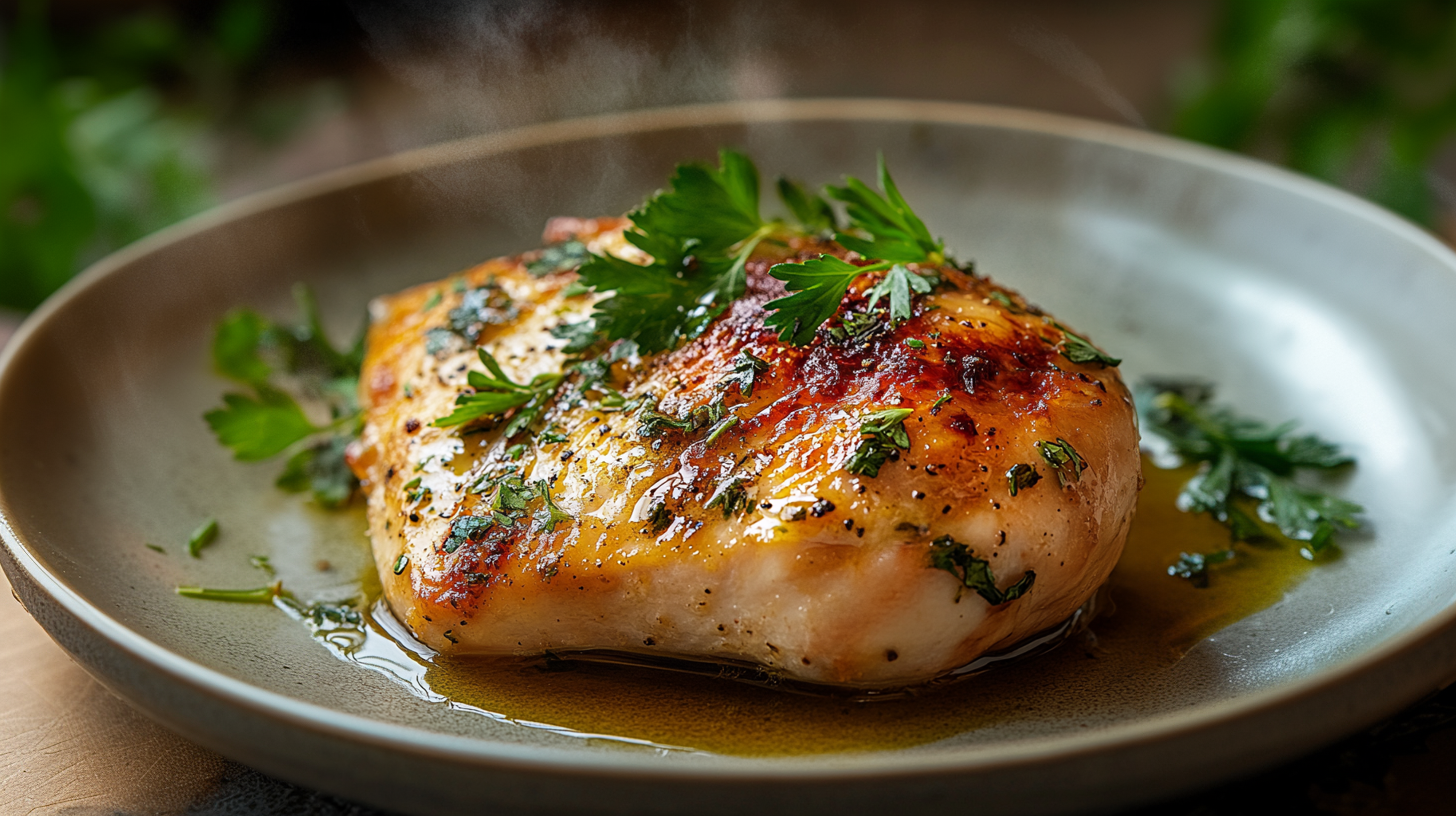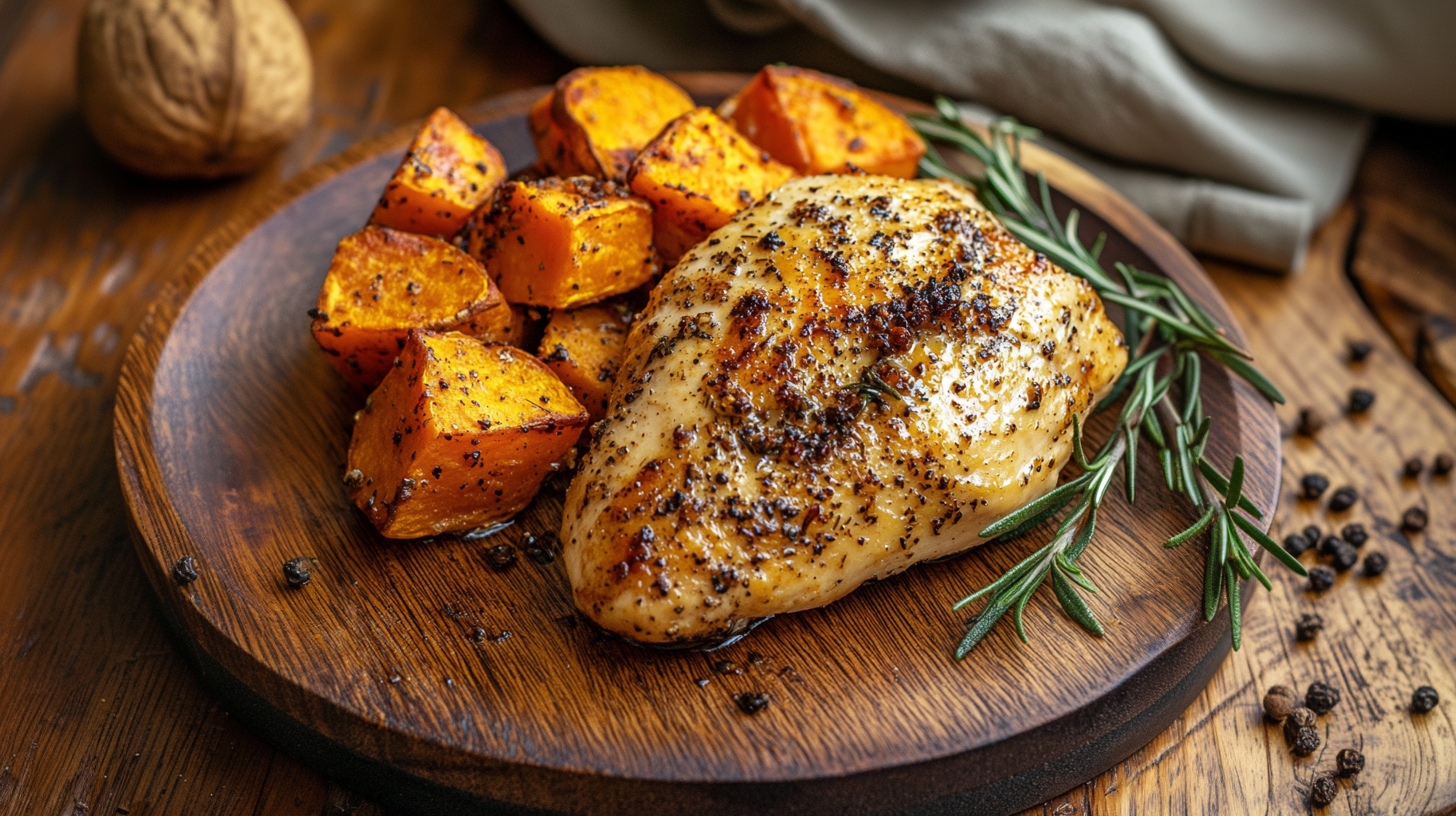Introduction
Is rotisserie chicken just as healthy as chicken ?
Rotisserie chicken has become a popular choice for quick, ready-to-eat meals. But many wonder, is rotisserie chicken just as healthy as chicken that’s cooked at home? This question is important for health-conscious individuals who prioritize balanced eating. While rotisserie chicken offers convenience, its preparation methods and seasonings can impact its nutritional value.
In this article, we’ll dive into the nutritional details of rotisserie chicken and compare it to other chicken preparations. We’ll explore the benefits, drawbacks, and ways to make rotisserie chicken a healthy part of your diet.
What is Rotisserie Chicken?
Rotisserie chicken is a whole chicken that is seasoned and cooked on a rotating spit. The constant rotation ensures even cooking, giving the chicken crispy skin and tender, juicy meat.
Rotisserie chickens are commonly sold at grocery stores and markets because they are affordable and convenient for customers. Unlike homemade chicken, these store-bought chickens are usually pre-seasoned, making them flavorful and ready to eat without any prep work.
How Rotisserie Chicken is Prepared
Rotisserie chicken is cooked using a rotating spit or rod in a heated oven or over an open flame. This slow-roasting method allows the chicken to cook evenly while keeping the moisture locked inside.
Before cooking, the chicken is often marinated or coated with seasonings. These may include salt, pepper, garlic powder, and other spices. Some stores add oil, butter, or sugars to enhance the flavor and give the skin a golden-brown color.
Although this method is efficient and tasty, the added ingredients can sometimes raise questions about the chicken’s overall health benefits.
Nutritional Comparison: Rotisserie Chicken vs Regular Chicken
When comparing rotisserie chicken to plain chicken cooked at home, the nutritional differences are noticeable.
- Calories: Rotisserie chicken, particularly the skin, tends to have more calories due to added oils or butter.
- Sodium: Store-bought rotisserie chickens often contain higher sodium levels because of seasonings and brining.
- Fat: While the meat itself is lean, the skin contains extra fat from cooking oils.
Homemade chicken, on the other hand, allows more control over ingredients, making it easier to manage sodium and fat content.
Is Rotisserie Chicken Just as Healthy as Chicken?
The keyphrase “Is rotisserie chicken just as healthy as chicken?” depends on how it’s prepared and consumed. Rotisserie chicken offers high-quality protein, vitamins, and minerals, similar to plain chicken. However, the added seasonings and fats can reduce its healthiness.
If you remove the skin, rotisserie chicken can be nearly as healthy as homemade chicken. The meat itself remains lean and nutrient-dense, providing essential nutrients like protein, iron, and B vitamins.
The Benefits of Eating Rotisserie Chicken
Rotisserie chicken provides several benefits that make it a popular choice:
- High Protein Content: Chicken is a great source of lean protein, which helps with muscle growth and repair.
- Convenience: It’s ready to eat, saving time and effort in meal preparation.
- Nutrient-Rich: Rotisserie chicken offers essential vitamins and minerals, such as vitamin B6, niacin, and selenium.
- Affordable: Compared to other takeout options, it is cost-effective and versatile.
These benefits make rotisserie chicken an appealing choice for busy families and individuals.
The Drawbacks of Rotisserie Chicken
While rotisserie chicken has advantages, there are also a few drawbacks to consider:
- High Sodium: Seasonings and brining add a significant amount of sodium, which can contribute to high blood pressure.
- Added Fats: Oils or butter used during cooking can increase fat content.
- Processed Ingredients: Some rotisserie chickens may contain preservatives, sugars, or artificial flavor enhancers.
If consumed in moderation and balanced with other healthy foods, these drawbacks can be minimized.
How Does Rotisserie Chicken Compare to Grilled Chicken?
Grilled chicken is often considered healthier than rotisserie chicken because it uses less oil and salt. The grilling process removes excess fat, making it a leaner option.
On the other hand, rotisserie chicken retains moisture better and tends to be more flavorful. If you remove the skin, rotisserie chicken can still be a healthy alternative to grilled chicken.
Both options are excellent sources of protein; it all comes down to preparation and portion control.
Is Rotisserie Chicken Better Than Fried Chicken?
When comparing rotisserie chicken to fried chicken, rotisserie chicken is the clear winner.
- Lower in Calories: Fried chicken absorbs more oil, increasing calorie and fat content.
- Less Saturated Fat: Rotisserie chicken has lower saturated fat levels, making it heart-friendlier.
- Nutritional Value: Rotisserie chicken retains more nutrients since it’s roasted rather than fried.
While fried chicken is tasty, rotisserie chicken is the better choice for a balanced diet.
The Role of Seasonings and Additives in Rotisserie Chicken
Seasonings play a major role in the flavor of rotisserie chicken but can also impact its healthiness.
- Sodium: Many pre-seasoned chickens contain high sodium levels.
- Sugars: Some marinades or rubs include added sugars.
- Fats: Oils or butter added during cooking increase calorie content.
Choosing a low-sodium option or removing the skin can make rotisserie chicken a healthier choice.
Can Rotisserie Chicken Be a Part of a Healthy Diet?
Yes, rotisserie chicken can be part of a healthy diet when consumed mindfully. To maximize its benefits:
- Remove the Skin: This reduces calories and fat.
- Pair with Vegetables: Serve it with roasted or steamed vegetables for a balanced meal.
- Choose Low-Sodium Options: Opt for plain rotisserie chicken whenever possible.
Rotisserie chicken’s convenience and nutrient content make it easy to incorporate into healthy meal plans.
Tips for Making Rotisserie Chicken Healthier
- Remove the skin before eating to reduce fat and calories.
- Rinse off excess seasonings to lower sodium.
- Use the meat in homemade dishes like salads, wraps, or soups.
- Pair it with nutrient-dense sides such as quinoa, brown rice, or leafy greens.
These tips ensure you enjoy rotisserie chicken without compromising on health.
How to Balance Rotisserie Chicken in Your Meal Plan
Balancing rotisserie chicken in your meal plan is simple:
- Portion Control: Stick to a serving size of about 3–4 ounces of chicken.
- Add Whole Grains: Serve with brown rice, quinoa, or whole-grain bread.
- Include Vegetables: Add plenty of colorful vegetables to your plate.
- Limit Sodium: Choose low-sodium rotisserie chicken and avoid adding extra salt.
By following these guidelines, you can enjoy a nutritious and satisfying meal.
Is Rotisserie Chicken Suitable for Weight Loss?
Rotisserie chicken can support weight loss when eaten in moderation. It’s high in protein, which helps you feel full longer and reduces cravings.
To make it more weight-loss-friendly:
- Remove the skin to cut down on fat.
- Pair it with low-calorie, high-fiber sides like broccoli or green beans.
- Avoid sugary sauces or dressings.
By making smart choices, rotisserie chicken can be part of a calorie-conscious diet.
Conclusion
So, is rotisserie chicken just as healthy as chicken prepared at home? It can be, depending on how it’s consumed. Rotisserie chicken offers convenience, high protein, and versatility, but it often contains added sodium and fats. By removing the skin and pairing it with healthy sides, you can enjoy this flavorful option without guilt.
Is Rotisserie Chicken Just as Healthy as Regular Chicken?
Rotisserie chicken is a convenient and affordable option for busy families, but how does it compare to regular chicken when it comes to health? The answer depends on how the chicken is prepared and what ingredients are added. Let’s break it down so you can make the healthiest choice for your meals.
Nutritional Differences
Rotisserie chicken is typically seasoned and cooked in-store, making it flavorful and ready to eat. However, this convenience often comes at the cost of added sodium and fat. Regular baked or grilled chicken, when cooked at home, allows you to control the seasonings, oils, and portion size for a healthier meal.
For tips on making the most of a store-bought rotisserie chicken, check out how to use rotisserie chicken for the week.
Is It Still Healthy?
Yes, rotisserie chicken can still be a healthy choice, especially when compared to fried options or processed meats. The key is to remove the skin, where most of the added fat and sodium reside. The meat itself, particularly the breast, is a good source of protein, vitamins, and minerals.
Want to know how long you can keep your leftover chicken safe to eat? Here’s a helpful guide: how long leftover rotisserie chicken stays good in the fridge.
The Role of Sodium
One downside to rotisserie chicken is its sodium content. Store-bought rotisserie chickens are often brined or seasoned heavily, which can lead to higher sodium intake. If you’re watching your salt levels, try making your own version at home for a healthier alternative.
Explore creative ways to reuse leftover chicken with these delicious leftover rotisserie chicken recipes.
Benefits of Homemade Chicken
If you’re looking to maximize health benefits, baking or grilling chicken at home is the best option. By cooking it yourself, you can:
- Reduce sodium by avoiding pre-made seasonings.
- Control fat content with minimal oils.
- Add flavor using herbs and spices instead of salt.
For more insight on chicken nutrition, check out trusted resources like Mayo Clinic’s guide to healthy proteins or Harvard’s School of Public Health.
Final Thoughts
Rotisserie chicken can be a healthy and practical choice when enjoyed in moderation and paired with nutritious sides like steamed veggies or quinoa. However, if you’re aiming for maximum control over nutrition, preparing chicken at home is the healthier route.
Whether you’re team rotisserie or regular chicken, the goal is to make choices that fit your lifestyle and nutritional needs. A little balance, creativity, and planning can go a long way to keeping meals healthy and delicious!
Frequently Asked Questions
1. Is rotisserie chicken a good source of protein?
Yes, rotisserie chicken is an excellent source of protein, which is essential for your body’s overall health. Protein plays a vital role in building and repairing muscles, supporting immune function, and providing energy. For individuals who exercise regularly or follow a high-protein diet, rotisserie chicken is a convenient way to meet daily protein requirements.
One serving of rotisserie chicken (about 3-4 ounces) provides approximately 20–25 grams of protein, which is similar to grilled or baked chicken. The high protein content keeps you feeling full for longer, reducing unnecessary snacking and helping you stick to healthier eating habits.
Another benefit is that rotisserie chicken is a complete protein, meaning it contains all nine essential amino acids your body needs but cannot produce on its own. These amino acids help with muscle recovery, metabolism, and maintaining lean body mass.
For busy individuals, rotisserie chicken is a practical solution. It’s ready-to-eat, saving time and effort without compromising nutritional value. Whether you use it in salads, wraps, or soups, the versatility of rotisserie chicken makes it an easy choice for meal prep.
To maximize its health benefits, remove the skin before eating. This simple step reduces excess fat and calories while maintaining the chicken’s protein content. Paired with vegetables or whole grains, rotisserie chicken becomes a well-balanced meal that supports muscle health and energy.
In short, rotisserie chicken is a fantastic, budget-friendly protein source that helps you stay full, maintain muscle, and eat healthier without the hassle of cooking from scratch.
2. Can rotisserie chicken help with weight loss?
Yes, rotisserie chicken can be a valuable part of a weight loss plan when consumed mindfully. One of the biggest benefits of rotisserie chicken is its high protein content, which promotes satiety and reduces cravings. Feeling full for longer helps you avoid overeating and makes it easier to stick to a calorie deficit—a key factor for weight loss.
For example, a 3-ounce serving of rotisserie chicken provides about 20–25 grams of protein while remaining relatively low in calories, especially if you remove the skin. Protein not only satisfies hunger but also boosts your metabolism because it takes more energy to digest compared to fats or carbs.
Rotisserie chicken also fits well into a variety of healthy meal plans. You can use it as a lean protein source in salads, wraps, or soups, all of which support a calorie-conscious diet. Pairing rotisserie chicken with high-fiber foods like leafy greens, quinoa, or roasted vegetables further enhances its weight loss benefits by providing bulk and nutrients without excess calories.
However, it’s important to pay attention to portion size and preparation. Store-bought rotisserie chickens may contain added sodium or oils that can increase calories. Removing the skin and opting for smaller portions can help you enjoy its benefits without compromising your goals.
In summary, rotisserie chicken is a convenient, high-protein option that supports weight loss by keeping you full, reducing cravings, and fitting easily into healthy meals. With smart choices, it becomes an ally in achieving your fitness and diet goals.
3. Is rotisserie chicken healthier than fried chicken?
Yes, rotisserie chicken is significantly healthier than fried chicken due to its lower fat, calorie, and oil content. While both options offer protein, the cooking methods set them apart in terms of nutrition.
Fried chicken is often coated in batter and deep-fried in oil, which adds unnecessary saturated fats and calories. For example, a typical fried chicken breast can have over 350 calories and 20 grams of fat, much of it coming from the frying process. In contrast, rotisserie chicken is roasted, which requires far less oil. As a result, it contains fewer calories and less unhealthy fat.
The roasting method of rotisserie chicken helps retain the natural nutrients and flavor of the meat without adding harmful trans fats or excessive oils. This makes it a better option for individuals trying to maintain heart health or reduce their caloric intake.
To get the healthiest version of rotisserie chicken, it’s best to remove the skin, which contains most of the added fats and seasonings. Doing so can cut the fat content by nearly half while keeping the meat’s protein intact.
Another benefit of rotisserie chicken is its versatility. It can be used in salads, sandwiches, or grain bowls as a lean protein source, whereas fried chicken is less adaptable for healthy meals due to its breading and oils.
In conclusion, rotisserie chicken is a much healthier alternative to fried chicken. By skipping the frying process, it reduces unnecessary fats and calories while delivering high-quality protein, making it an excellent choice for balanced eating.
4. Is rotisserie chicken a good option for meal prep?
Absolutely. Rotisserie chicken is one of the most convenient and versatile options for meal prep. It’s fully cooked, saving you time and effort in the kitchen, which is perfect for busy schedules. Whether you’re planning lunches for the week or preparing family dinners, rotisserie chicken simplifies the process while offering a nutritious protein source.
One of the greatest benefits of using rotisserie chicken for meal prep is its versatility. The meat can be shredded, chopped, or sliced and added to a variety of dishes:
- Salads: Use shredded chicken for high-protein salads with greens and healthy dressings.
- Wraps and Sandwiches: Add rotisserie chicken to whole-grain wraps or bread with fresh vegetables.
- Soups and Stir-fries: Incorporate chicken into hearty soups, stews, or stir-fried vegetables.
Rotisserie chicken also reduces food waste. You can use the meat for several meals throughout the week and even use the bones to make homemade chicken broth. It’s a cost-effective way to stretch your grocery budget.
Nutritionally, rotisserie chicken is a lean protein source that pairs well with other healthy foods like vegetables, quinoa, or brown rice. To make it healthier, remove the skin to reduce extra fats and calories.
With proper storage, rotisserie chicken can last up to 4 days in the fridge, making it ideal for batch-cooking your meals in advance.
In short, rotisserie chicken is an excellent option for meal prep. It’s affordable, convenient, and versatile, allowing you to create balanced, nutritious meals without the hassle of starting from scratch.
5. Does rotisserie chicken provide essential nutrients?
Yes, rotisserie chicken is packed with essential nutrients that are beneficial for overall health. It is a rich source of high-quality protein, vitamins, and minerals, making it an excellent addition to a balanced diet.
- Protein: Rotisserie chicken provides about 20–25 grams of protein per serving. Protein is crucial for building and repairing muscles, maintaining skin health, and supporting immune function.
- B Vitamins: It’s a great source of vitamin B6 and niacin, which help with energy production, metabolism, and brain function. These nutrients keep your body’s systems running efficiently.
- Selenium: This trace mineral supports thyroid health and acts as a powerful antioxidant that helps protect your cells from damage.
- Phosphorus: Rotisserie chicken contains phosphorus, an essential nutrient for strong bones and teeth.
Rotisserie chicken is also low in carbohydrates, making it an ideal protein source for those following low-carb or keto diets.
To get the most nutrients, focus on eating the white meat (breast) portions, which are leaner and lower in fat compared to dark meat. If you’re concerned about added seasonings or oils, removing the skin can significantly reduce sodium and fat content while maintaining the chicken’s nutritional benefits.
In summary, rotisserie chicken is not only delicious but also nutrient-dense. It delivers essential proteins, vitamins, and minerals that support muscle growth, energy production, and overall wellness. With mindful consumption, it can easily become a healthy staple in your diet.






